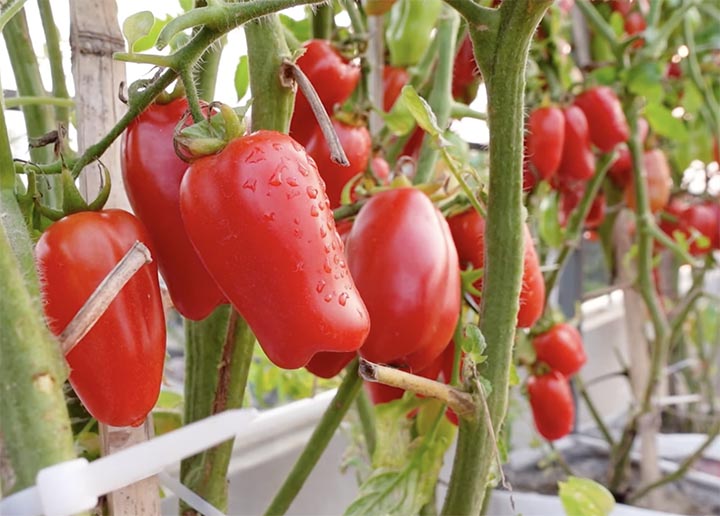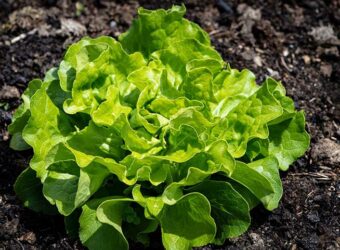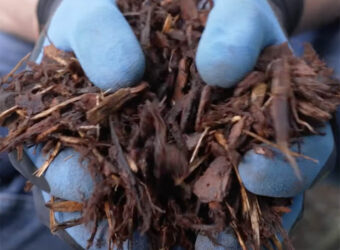San Marzano tomatoes are famous among cooks for their flavor. You may be interested in trying to grow them for yourself. This guide tells you how.
Quick Growing Guide for the San Marzano Tomato
| Plant Type | Indeterminate | Resistant to | Fusarium Wilt, Root Knot Nematode, Tomato Mosaic Virus, Verticillium Wilt |
| USDA Hardiness Zone | 3-9 | Maintenance | Moderate to High |
| Season | Summer, early fall | Soil Type | Fertile, well aerated |
| Exposure | Full Sun | Soil pH | 6.2-6.8 |
| Time to Maturity | 80 days | Soil Drainage | Well-drained |
| Water Needs | Moderate | Companion Plants | Lettuce, basil, beets |
| Planting Depth | ¼ inch deep | Don’t Plant Near | Potatoes, peppers, eggplants |
| Spacing | 2-3 feet | Family | Solanaceae |
| Height | 40-48 inches | Genus | Solanum |
| Spread | 18 inches | Species | lycopersicum |
| Common Pests and Diseases | Hornworm, tomato beetle, Anthracnose | Variety | San Marzano |
What Is a San Marzano Tomato?
A San Marzano tomato is an oblong paste tomato from Italy.
Cultivation and History
San Marzano tomatoes were developed in the San Marzano region of Italy. A tomato handbook from the 1940s lists it as a cross between the Re Umberto and Fiaschetto tomato varieties. The San Marzano tomato is protected by the Italian government, and only San Marzano tomatoes grown in that region can be called San Marzano tomatoes. Many are grown in the volcanic soil around Mt. Vesuvius. San Marzano tomatoes were brought to the United States in the late 1890s for canning. Many are canned as “San Marzano style” tomatoes to avoid copyright infringement.
Characteristics of the San Marzano Tomato
Growth Habit
The San Marzano tomato is an indeterminate tomato plant.
Fruit Size, Color, Texture, Taste
This tomato is long and blocky. Seeds are in a separate capsule within the tomatoes, making removal easy. The flesh of these red tomatoes is meaty, red, and thick. San Marzano tomatoes are low in acidity and easy to peel. They taste sweet and rich, with a complex jam flavor. They are generally used as canning tomatoes and in sauces.
Tomato Type
Open-Pollinated Heirloom
Plant Resistant
San Marzano tomato plants are resistant to Fusarium Wilt, Root Knot Nematode, Tomato Mosaic Virus, and Verticillium Wilt, according to the Cornell database of resistance in tomato plants.
Caring for the San Marzano Tomato
San Marzano tomatoes take a long time to start producing tomatoes, eighty days. Here is what they need to grow big and juicy.
Light
San Marzano tomatoes should be planted in full sun. They thrive in at least eight hours of sunlight. I live in a hot climate, so I plant them where they get afternoon shade or use shade cloth to keep them from getting too hot. This isn’t necessary for cooler climates.
Soil
The best thing you can do for your San Marzano tomato plants is to get a soil test. This test will tell you the pH of your soil and what nutrients are present in your soil. It will also include fertilizer recommendations. You can get soil sample instructions from your Extension agent or agricultural advisor.
Tomatoes grow best with a pH that is 6.2-6.8. Soil needs to be well-drained and fertile. I add fertility by spreading three inches of compost on the area where I will grow your tomatoes. I work the compost into the top six inches of soil. I then take my soil sample for my soil test after this. When I get the results, I follow the recommendations of the results and fertilize the area. I water well to activate the fertilizer. I am now ready to plant my San Marzano tomato plants.
Planting
You can grow San Marzano tomato plants from seeds or transplants. For complete instructions on starting seeds and planting transplants, see my article, “How to Grow Tomatoes – The Ultimate Guide.”
When to Plant San Marzano Tomatoes
San Marzano tomato plants should be planted after all danger of frost has passed and the temperature is at least 70 degrees F at night.
Water
The San Marzano tomato is a meaty tomato. To get that way, the plant requires plenty of water. I keep the soil evenly moist the entire time from planting to removing the plant after the frost. I use an inexpensive moisture meter to help me do that. Give the tomato plant an inch of water a week until it sets fruit, then give it two inches of water. If you live in a hot climate as I do, water twice a week to keep the soil moist.
Temperature
Tomatoes are a warm-season crop. I do not plant my San Marzano tomato plants until the frost has passed and the soil has warmed up. The temperature needs to be at least 70 degrees all the time for the tomato plants to flourish. I have found planting the San Marzano tomato plants too early means they are stunted by the cold and do not produce as much.
When the temperature is over 90 degrees, the pollen in the San Marzano tomato blossoms is made infertile by the heat. The blooms will just fall off instead of setting fruit. I have found it is better to pull the tomato plants out at this point and start fresh in the fall instead of trying to nurse the tomato plants through the summer and have them start producing in the fall. The plants that go through the stop in production never seem to produce as many tomatoes in the fall as fresh plants do.
Fertilizer
Follow the soil test (discussed above) recommendations to get your soil ready for the tomato plants. In the absence of a soil test, spread around four pounds of 10-10-10 fertilizer per 100 feet of row and water it in. I live in an area with a high phosphorus and potassium level in my soil, so I use a pound of 46-0-0 per 100 feet of row instead.
After the fruit sets, start fertilizing every two weeks with a liquid or four weeks with a granular fertilizer until the vine dies. For more on fertilizing tomatoes, read my article.
Pruning
Indeterminate tomato plants like the San Marzano benefit from pruning. You need to wait to prune the plant until the first flower cluster appears. I pull off the shoots near the soil level first. Then I pull off the shoots that sprout where the branch meets the stem, except for the ones just below the flower cluster. This redirects the energy the plant would have spent growing foliage into growing more tomatoes.
Why Plant San Marzano Tomatoes?
San Marzano tomatoes are excellent for canning. They hold their taste even after processing. The seed capsule is at one end, so it is easy to remove. The skin is thin and peels off easily. These things are important if you are going to can a lot of tomatoes and make sauce from them.
Where to Buy San Marzano Tomatoes
You can buy San Marzano tomato plants at many nurseries. I have not found them at big box stores. Gurney’s has plants and seeds for sale by mail, as does Burpee’s, Totally Tomatoes and Amazon have seeds.
Pest & Diseases
San Marzano tomato plants are resistant to Fusarium Wilt, Root Knot Nematode, Tomato Mosaic Virus, and Verticillium Wilt. They do get other diseases, however. You can find a complete list of known tomato diseases in my tomato diseases article.
San Marzano tomato plants are vulnerable to several pests. If you have any pest problems with this type of tomato, check out our tomato pest guide for solutions.
Harvesting
I harvest San Marzano tomatoes when they are a deep red but still firm. I store them on the counter because they get mealy and mushy in the refrigerator.
Common Uses of San Marzano Tomato
San Marzano tomatoes are best canned. They can be eaten fresh, but I prefer something like Big Boy or Celebrity to eat fresh. San Marzano tomatoes also cook down quickly into a delicious sauce. Remember to add two tablespoons of lemon juice or ½ teaspoon of citric acid per quart or one tablespoon of lemon juice or ¼ teaspoon of citric acid per pint directly to the canning jars when canning using the water bath method. You don’t want to get poisoned because the tomatoes are low in acid.
Another good use for San Marzano tomatoes is drying them. Cut them in half, remove the seeds, and spread them out on a tray. Make sure the halves do not touch each other. Stir the tomatoes daily until they reach the desired dryness. Store in an airtight container like a jar in a cool, dry place.
In conclusion, the San Marzano tomato is an open-pollinated, heirloom variety from Italy. The indeterminate vine will grow the entire season and produce tomatoes starting at 80 days until frost or heat stops it. These red, meaty tomatoes are best used canned or dried. They are taken care of like any other tomato plant. Enjoy your San Marzano tomatoes!






